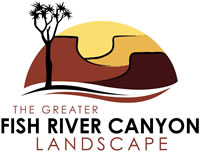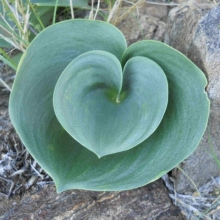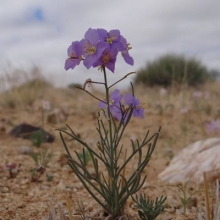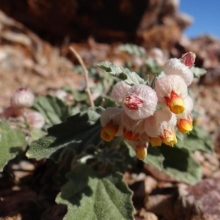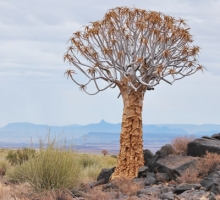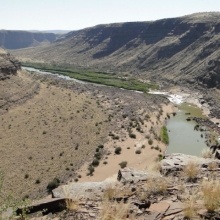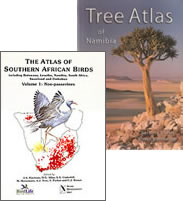Flora
Vegetation
The landscape is in the hyper-arid zone. It falls within the transition belt between summer and winter rainfall and consequently has elements of both succulent winter rainfall and woody summer rainfall vegetation. The high mountains, deep valleys, perennial Orange River and effects of coastal fog (in the extreme west) contribute to adding further habitat diversity to this area. The landscape extends across two biomes, the Nama Karoo and the Succulent Karoo, and the transition zone between them.
The Succulent Karoo ecosystem is recognised as one of the 25 biological ‘hotspots’ of the world and is the only arid region to be so recognised. The Succulent Karoo has a unique and exceptionally diverse flora with many endemic species, especially succulents and bulbs - an adaptation to the extremely arid conditions. There are at least 100 endemic plant species in the /Ai-/Ais Hot Springs Game Park. Other adaptations include white scales which reflect light, sticky hairs which trap sand grains to form a protected shell and reduce the drying effects of wind, and poisonous sap and spines to deter browsers. In addition to the rich plant life, this area is also a centre of diversity for reptiles and various invertebrate groups, and supports a variety of mammals and many of southern Africa's endemic birds.
Four main vegetation types occur within the landscape, the Succulent Steppe in the south and south-west, the Desert - Dwarf Shrub Transition, the Dwarf Shrub Savanna and the Karas Dwarf Shrubland. Hillsides are typically dominated by Euphorbia, Aloe and Boscia species, while on the plains, the dominant species include Rhigozum trichotomum, Parkinsonia africana and grasslands dominated by Stipagrostis species. Larger drainage lines are vegetated with Acacia erioloba, A. karroo, Tamarix usneoides, Euclea pseudebenus, Rhus lancea and others.
Relevant literature
-
Biodiversity zonation of the Greater Fish River Canyon Landscape
Burke, A. 2013. Biodiversity zonation of the Greater Fish River Canyon Landscape. Report of field survey in the Nama Karoo area
As part of a biodiversity zonation for the Greater Fish River Canyon Landscape the summer fieldtrip April-May 2013 targeted six areas, which were selected on the basis of data gaps, representation of the landscape and rainfall patterns. The Orange River mountains proved the most exciting from a plant research perspective, as new distribution records may have been found here.» Download -
Biological characterisation of the Orange-Fish River Basin, Namibia
Irish, J. 2009. Biological characterisation of the Orange-Fish River Basin, Namibia. Report produced for the Ephemeral River Basins in Southern Africa (ERB) Project, Desert Research Foundation of Namibia (DRFN: Windhoek)
Ephemeral River Basins (ERB) in Southern Africa is a project that promotes the sustainable, equitable and improved utilisation of water and other natural resources in ephemeral river basins in southern Africa through the process of integrated resource management (IWRM). Although IWRM is accepted – internationally and regionally – as the approach promoting sustainable management of water resources and the river basin is considered the ideal unit over which to apply it, the basin management approach has not been widely tested and implemented in ephemeral river basins in southern Africa.» Download -
Burke A. (2020) Endemic plants of the Sperrgebiet. EnviroScience & Namibian Chamber of Environment, Windhoek.
Burke A. (2020) Endemic plants of the Sperrgebiet. EnviroScience & Namibian Chamber of Environment, Windhoek.
This photographic guide book introduces plants endemic to Namibia and is written for non-specialists.» Download -
Endemic plants of the Sperrgebiet. Poster 1 by EnviroScience
Endemic plants of the Sperrgebiet. Poster 1 by EnviroScience
» Download -
Endemic plants of the Sperrgebiet. Poster 2 by EnviroScience
Endemic plants of the Sperrgebiet. Poster 2 by EnviroScience
» Download -
Endemic plants of the Sperrgebiet. Poster 3 by EnviroScience
Endemic plants of the Sperrgebiet. Poster 3 by EnviroScience
» Download -
Endemic plants of the Sperrgebiet. Poster 4 by EnviroScience
Endemic plants of the Sperrgebiet. Poster 4 by EnviroScience
» Download -
Managing biodiversity in the /Ai-/Ais Hotsprings Game Park
Burke, A. 2011. Managing biodiversity in the /Ai-/Ais Hotsprings Game Park. A tool for conservation-, resource- and development planners. EnviroScience & SPAN
The /Ai-/Ais Hotsprings Game Park is the Namibian Section of the /Ai-/Ais/Richtersveld Transfrontier Park (ARTP) in the south of Namibia. Although a joint management plan exists for the Transfrontier Park, detailed information on biodiversity in the Namibian section of the park was lacking. This document addresses this gaps and describes landscape units and their biodiversity importance, highlights knowledge gaps reviews current land uses and proposed zoning and provides guidelines for managing these landscape units.» Download -
Managing biodiversity of the Greater Fish River Canyon Landscape
Burke, A. 2013. Managing biodiversity of the Greater Fish River Canyon Landscape - A tool for sustainable land management. EnviroScience and Namplace, Windhoek, 92 pp
A biodiversity zonation for the Ai-Ais Hotsprings Game Park completed in 2011 was extended to include the Greater Fish River Canyon Landscape. Plants were used as indicators in this conservation planning study, because of the comparatively good information base, their importance for ecological processes and their ready use as indicators at a landscape level.» Download -
Plant species of the Naute Game Park
Burke, A. 2014. Plant species of the Naute Game Park – an annotated inventory. Dinteria 34: 3-11
This paper presents an inventory of plants of the Naute Game Park, based on field surveys and information from databases. The park extends over two quarter degree squares and 159 terrestrial plant species have to date been recorded. Deciduous dwarf shrubs comprise the majority of the flora. The rare, small tree Elephantorrhiza rangei and populations of quiver tree (Aloe dichotoma), Nama corkwood (Commiphora namaensis), Nama resin-tree (Ozoroa namaensis) and black-winged twin-leaf (Zygophyllum cretaceum) are of conservation importance on the inselbergs. Also of conservation importance are the Namibian endemics Euphorbia lignosa, Geigeria brachycephala, Indigofera pechuelii, Phyllanthus dinteri, Salsola arborea and kinkelbos (Tetragonia schenkii) as well as unidentified dwarf stem-succulent Apocynaceae (Stapeliod) and Hoodia species. Invasive alien mesquite (Prosopis) trees may locally pose a threat to indigenous plants. More stringent track control in the recreational part of the park would limit the disturbance of natural habitat.» Download -
Species list - grasses of Gondwana Canyon Park
Gondwana Canyon Park species list of grasses
» Download -
Species list - shrubs and trees of the Gondwana Canyon Park
Gondwana Canyon Park species list of shrubs and trees
» Download -
Species list - Tree Atlas of Namibia list of trees
Tree Atlas of Namibia species list of trees
Tree Atlas of Namibia species list of trees recorded in the Greater Fish River Canyon landscape» Download -
Wildflowers of the Southern Namib
Mannheimer C.A., Maggs-Kölling G., Kolling H. & Rügheimer S. 2008. Wildflowers of the Southern Namib. Windhoek. 292 pp. ISBN: 978-99916-0-878-5
